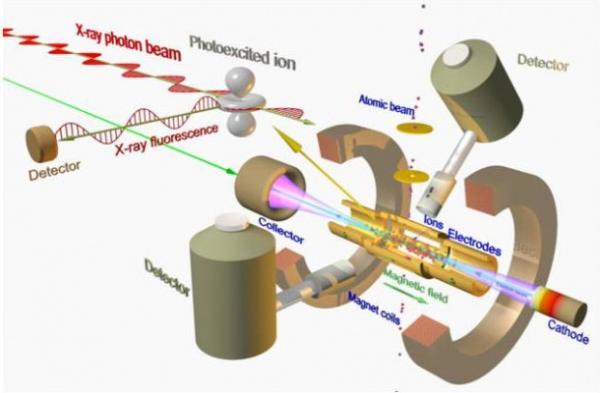Electron Beam Ion Trap (EBIT) End Station (Collaborative Access)

The Electron Beam Ion Trap (EBIT) end station, outlined in the figures, is a system dedicated to the investigation of the interaction of light with dilute clouds of trapped highly charged ions (HCI). It is especially designed to explore the interaction of photons with highly charged ions in any desired charge state. Such ions are ubiquitous in astrophysics and high temperature plasmas and have also important applications for studies of fundamental interactions.
Scientific goals include: The determination of photoionization and photo absorption cross sections, both of utmost importance for astrophysics; the production, trapping and investigation of photoionized samples of strongly correlated warm, dense plasmas, this point representing one of the forefront topics of present plasma physics research; the direct photoexcitation of low-lying nuclear levels, which would imply a significant advance in nuclear physics. Precision measurements on the electronic level structure of HCIs shall be performed to test fundamental theories (QED) and parity non-conservation in the neutral currents sector. Future work will also aim at the preparation and control of highly excited coherent quantum states with combined XFEL and optical lasers.

The end station consists of a fully operational EBIT. It is equipped with various spectrometers for visible, VUV, X-ray or fluorescence photon detection, including an X-ray microcalorimeter. Eight ports transverse to the LCLS beam give access for intense lasers into the trap region as well as for injecting gaseous targets. One axial port permits ion/photo ion extraction and charge analysis of the extracted ions on a position-sensitive detector. The complete end station requires ~4 x 2 m2 floor space and weights about 2 tons. It is further equipped with diagnostic tools to guarantee the overlap between the LCLS beam with the ion cloud and to measure the photon beam energy in a pulse-by-pulse mode. The present transportable EBIT end station operation has been tested at the soft X-ray free electron laser FLASH, as well as at the BESSY II and PETRA III synchrotrons. The collaboration intends to develop and commission a new, dedicated user EBIT end station for LCLS after the initial experimental phase.
